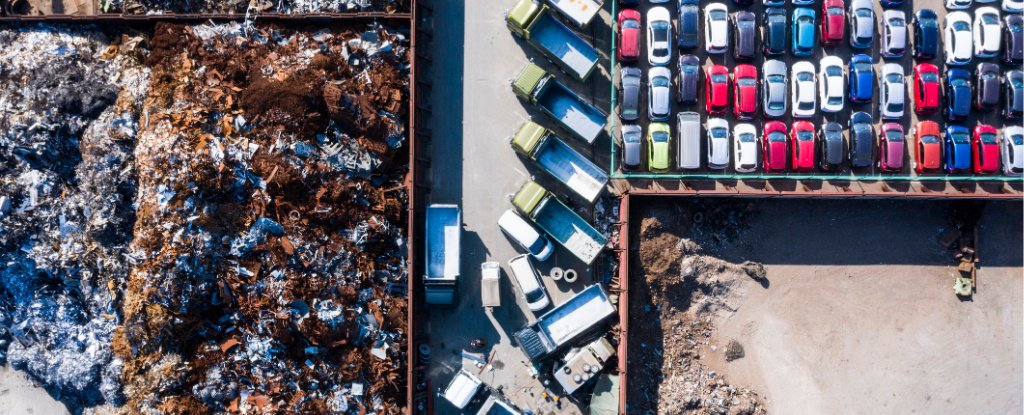
Aerial photo of waste disposal site. (kokouu/Getty Images)
ENVIRONMENT
DAVID NIELD
25 JULY 2020
Thermosets are some of the toughest plastics around. They're used in products that have to be particularly durable and heat-resistant – but that also makes them very difficult to break down and recycle.
That could change with the help of new research into the chemical bonds that hold these thermosets together. The study suggests that by changing the way they're made, we could keep the original strength of these thermosets, but make them able to be broken down and recycled.
Currently, around 75 percent of the plastic we use in items such as plastic wrappers and plastic bags can be broken down and then reused. But thermosets, which are found in things such as car parts, aren't reusable.
The new approach involves slightly adjusting the mixture that makes up thermoset plastic, adding particular types of building blocks (or monomers) called silyl ethers that are more susceptible to being pulled apart and reshaped.
"This work unveils a fundamental design principle that we believe is general to any kind of thermoset with this basic architecture," says chemist Jeremiah Johnson, from the Massachusetts Institute of Technology (MIT).
The same research team had previously used silyl ether monomers in other types of synthetic plastic – plastics which shared some common characteristics with thermosets.
Here, they showed the same approach could work for thermoset plastics too.
In particular, the latest study looked at the thermoset polydicyclopentadiene (pDCPD), which can typically be found in truck and bus body panels: great for vehicle strength and durability, but not so great for recycling.
By making silyl ether 7.5 to 10 percent of the liquid precursor to pDCPD, the team was able to create a new blend of the plastic – one that could retain its mechanical strength but which broke down on contact with fluoride ions.
The revamped formula passed another key test as well – not only could they be broken down, the products could be reused.
The researchers were able to form new pDCPD products from the dissolved power left by the first recycling stage. It's likely that other thermosets can be modified in this way too.
"That new material has nearly indistinguishable, and in some ways improved, mechanical properties compared to the original material," says Johnson. "Showing that you can take the degradation products and remake the same thermoset again using the same process is exciting."
The process outlined here uses degradable monomers to form the actual individual polymer strands, and it improves on previous approaches where only the bonds linking the strands were actually degradable.
The next step is to see how widely this innovative approach can be applied, and if the new technique can be successfully implemented into the production of pDCPD and other thermosets.
With global plastic pollution already at crisis levels, we need to find some solutions as soon as we possibly can.
"Thermosets – polymeric materials that adopt a permanent shape upon curing – have a key role in the modern plastics and rubber industries, comprising about 20 percent of polymeric materials manufactured today, with a worldwide annual production of about 65 million tons," the researches write in their paper.
"Optimisation of the cleavable bond location can be used as a design principle to achieve controlled thermoset degradation. Moreover, we introduce a class of recyclable thermosets poised for rapid deployment."
The research has been published in Nature.
No comments:
Post a Comment